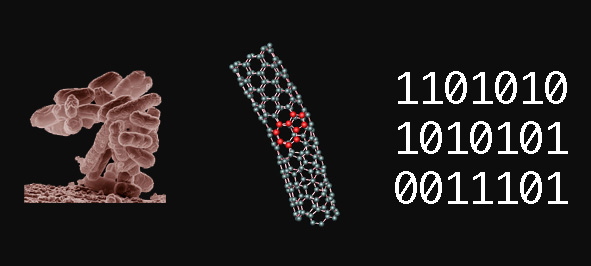All Together Now
As Emerging Technologies Converge, So Should Ethical Discussions
 SOURCE: USDA, Vin Crespi, Pennsylvania State Physics, SP
SOURCE: USDA, Vin Crespi, Pennsylvania State Physics, SPHow many bioethics subfields do we really need to grapple with the issues at the cutting edge of contemporary science? Maybe just one. An interview with Gregory Kaebnick and Andrew Light.
Gregory Kaebnick and Andrew Light talk with Managing Editor Andrew Pratt About the Ethics of Emerging Technologies
Listen online or download the full conversation:
 All Together Now - The Ethics of Emerging Technologies [50:38m]: Hide Player | Play in Popup | Download (58)
All Together Now - The Ethics of Emerging Technologies [50:38m]: Hide Player | Play in Popup | Download (58)Subscribe to Science Progress podcasts through iTunes.
Nanoethics. Neuroethics. Synbioethics. How many bioethics subfields do we really need to grapple with the issues at the cutting edge of contemporary science? Maybe just one, suggest the authors of a recent report from the Hastings Center and the Woodrow Wilson Center for International Scholars: an ethics of emerging technologies. The reason being that emerging technologies are not diverging from one another—rather, they are converging. As these fields begin to overlap, sharing tools and techniques, so too do the ethical questions converge. Namely, they raise the potential for both physical harms we must consider—unforeseen environmental damage from nanomaterials or synthetically engineered bioterrorism weapons—as well as nonphysical harms that might result from the inequitable distribution of, for instance, new drugs or energy sources built on nanotech or synthetic biology.
To explore these ethical approaches to emerging technologies Science Progress spoke with Gregory E. Kaebnick, editor of the Hastings Center Report and principal investigator on the Center’s “Ethical Issues in Synthetic Biology” project, and Andrew Light, a Senior Fellow at the Center for American Progress. Because the field is advancing so rapidly, scientists, ethicists, and policymakers must address the social and ethical issues now, as it still matures, argue Kaenick’s colleagues, the authors of the new study. (To listen to the podcast of our conversation, see the audio player in the sidebar, download the mp3, or subscribe via iTunes.)
Ethical Issues in Synthetic Biology
By Erik Parens, Josephine Johnston, and Jacob Moses of The Hastings Center
Synthetic biology, commonly referred to as “synbio,” is not one particular technology, but “more of an agenda” to use existing scientific tools to do rather than simply understand biological science, Kaebnick explained. Synbiologists “create and modify biological parts and organisms” using “a confluence of a variety of technologies” including DNA synthesis, information processing, and DNA sequencing, he said. The techniques can yield medicines, fuel, and industrial chemicals. Moreover, Light added that synbio shares many important concepts and jargon with information technology. Synthesizing DNA, for instance, is analogous in some ways to programming a machine to make it perform a specific task.
But what about the potential benefits promised by emerging technologies like synthetic biology and nanotech? One likely benefit, Light explained, may come from the intersection of nano and synbio energy research. Scientists in multiple U.S. labs are working to develop artificial photosynthesis, a process in which engineered cells turn water, sunlight, and carbon into biofuel. Light pointed to this as an important area of renewable energy research because it could help harness the 800 terawatts of solar energy striking the Earth at any given moment and transform it into useable resources. “This is at least one reason why I think we could see a big benefit if this technology develops in a responsible way,” he said.
Another important advance is in the artificial production of artemisinic acid, the precursor for artemisinin, an effective treatment for drug-resistant malaria. Kaebnick called it the “poster child for synbio,” as natural wormwood sources for the compound are expensive and rare.
Despite these potential benefits, synbio raises a number of concerns. One of the greatest risks is bioterrorism, Kaebnick said, as DNA synthesis techniques could be used to reproduce a variety of pathogens. For example, with the appropriate gene sequences, rogue scientists could recreate the polio virus or smallpox. They could even reengineer smallpox so it is more deadly than the original disease, he explained.
Bioterrorism is a clear potential physical harm. In contrast, potential nonphysical harms present philosophical questions that range from “Are we over stepping our bounds as humans?” by engineering artificial life forms to “Who should have access to life-extending drugs?”
For example, Light suggested, if scientists develop a drug that radically extends the human lifespan, it may not be immediately accessible to the whole population although there would be “enormous pressure to invest in this technology,” he said.
A similar concern is creating whole organisms with synthetic DNA, Kaebnick said. Environmental preservation champions who believe “we ought to preserve biodiversity and rare organisms” even if it is “economically disadvantageous” oppose such synbio research. He went on: “Down the road, we may have the ability to control our children’s development in utero,” using emerging technologies. Ethical issues in this area of synbio are similar to existing concerns raised by assisted reproductive technologies.
A number of regulations are already in place for synbio, Kaebnick said, as rules for biotechnology often spill over to technologies used in synbio. Regulations enforced by the Environmental Protection Agency, Department of Agriculture, and other federal agencies may apply to emerging technologies as well, he explained. However, Light said there are still gaps left when considering synbio research, and due diligence will be necessary to prevent their exploitation. “The attitude is not to keep synbio from happening,” he said, but rather to create and maintain public confidence in its benefits.
Interview produced by Andrew Plemmons Pratt, managing editor for Science Progress, and Vivian Cheng, intern with Science Progress.
http://www.scienceprogress.org/2009/07/all-together-now/
Etiquetas: Nanotech, Synthetic Biology

0 Comentarios:
Publicar un comentario
Suscribirse a Comentarios de la entrada [Atom]
<< Página Principal